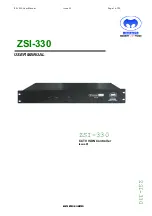
© Koninklijke Philips Electronics N.V. 2006. All rights reserved.
User manual
Rev. 01 — 12 January 2006
12
Philips Semiconductors
UM10161
Volume 1
Chapter 2: Memory map
2.2.2 Memory
re-mapping
In order to allow for compatibility with future derivatives, the entire Boot Block is mapped
to the top of the on-chip memory space. In this manner, the use of larger or smaller flash
modules will not require changing the location of the Boot Block (which would require
changing the Boot Loader code itself) or changing the mapping of the Boot Block interrupt
vectors. Memory spaces other than the interrupt vectors remain in fixed locations.
shows the on-chip memory mapping in the modes defined above.
The portion of memory that is re-mapped to allow interrupt processing in different modes
includes the interrupt vector area (32 bytes) and an additional 32 bytes, for a total of
64 bytes. The re-mapped code locations overlay addresses 0x0000 0000 through
0x0000 003F. A typical user program in the Flash memory can place the entire FIQ
handler at address 0x0000 001C without any need to consider memory boundaries. The
vector contained in the SRAM, external memory, and Boot Block must contain branches to
the actual interrupt handlers, or to other instructions that accomplish the branch to the
interrupt handlers.
There are three reasons this configuration was chosen:
1. To give the FIQ handler in the Flash memory the advantage of not having to take a
memory boundary caused by the remapping into account.
Table 3:
ARM exception vector locations
Address
Exception
0x0000 0000
Reset
0x0000 0004
Undefined Instruction
0x0000 0008
Software Interrupt
0x0000 000C
Prefetch Abort (instruction fetch memory fault)
0x0000 0010
Data Abort (data access memory fault)
0x0000 0014
Reserved
Note:
Identified as reserved in ARM documentation, this location is used
by the Boot Loader as the Valid User Program key. This is described in
detail in
Section 19.4.2 “Criterion for valid user code”
.
0x0000 0018
IRQ
0x0000 001C
FIQ
Table 4:
LPC2101/02/03 memory mapping modes
Mode
Activation
Usage
Boot
Loader
mode
Hardware
activation by
any Reset
The Boot Loader
always
executes after any reset. The Boot Block
interrupt vectors are mapped to the bottom of memory to allow
handling exceptions and using interrupts during the Boot Loading
process.
User
Flash
mode
Software
activation by
Boot code
Activated by Boot Loader when a valid User Program Signature is
recognized in memory and Boot Loader operation is not forced.
Interrupt vectors are not re-mapped and are found in the bottom of the
Flash memory.
User RAM
mode
Software
activation by
User program
Activated by a User Program as desired. Interrupt vectors are
re-mapped to the bottom of the Static RAM.













































